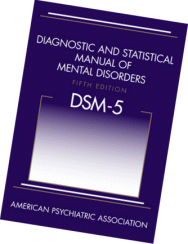This post is part of a series of guest posts on GPS by the graduate students in my Psychopathology course. As part of their work for the course, each student had to demonstrate mastery of the skill of “Educating the Public about Mental Health.” To that end, each student has to prepare two 1,000ish word posts on a particular class of mental disorders.
______________________________________________
Thing One and Thing Two – The Impact of Comorbidity on Tic Disorders by Melody Reynalds
For those who are suffering from them, many times nothing could be worse than having a mental disorder…unless you have two, or dare I say, three. It seems reasonable to think that as the number of disorders increased in a person, their quality of life would decrease, but hold that thought. First, we should understand what a mental disorder is.
 The most recent version of the Diagnostic and Statistical Manual for Psychiatric Disorders (DSM-5) defines a mental disorder as a syndrome characterized by clinically significant disturbance in an individual’s cognition, emotion regulation, or behavior that reflects a dysfunction in the psychological, biological, or developmental processes underlying mental functioning. Mental disorders are usually associated with significant distress or disability in social, occupational, or other important activities. An expectable or culturally approved response to a common stressor or loss, such as the death of a loved one, is not a mental disorder. Socially deviant behavior (e.g., political, religious, or sexual) and conflicts that are primarily between the individual and society are not mental disorders unless the deviance or conflict results from a dysfunction in the individual, as described above.
The most recent version of the Diagnostic and Statistical Manual for Psychiatric Disorders (DSM-5) defines a mental disorder as a syndrome characterized by clinically significant disturbance in an individual’s cognition, emotion regulation, or behavior that reflects a dysfunction in the psychological, biological, or developmental processes underlying mental functioning. Mental disorders are usually associated with significant distress or disability in social, occupational, or other important activities. An expectable or culturally approved response to a common stressor or loss, such as the death of a loved one, is not a mental disorder. Socially deviant behavior (e.g., political, religious, or sexual) and conflicts that are primarily between the individual and society are not mental disorders unless the deviance or conflict results from a dysfunction in the individual, as described above.
Make sense? Well, maybe not entirely. However, sense or no sense, this definition is the template by which the mental disorder is defined and conceptualized. As mentioned, this definition is from the most recent version of the DSM-5, implying that other versions existed previously. As times change, so do the meaning and value of ideas. For example, segregation was once a perfectly acceptable idea but has changed over the course of many years. What was once accepted at large, is now thought of as barbaric. More recently, the status of Pluto as a planet has been a stimulating topic of debate. Science changes and psychology is no different; the definition of a mental disorder has changed across time.
So have you decided which is better – one disorder or two? Having two disorders is referred to as comorbidity (the simultaneous presence of two or more chronic diseases or conditions in an individual). Comorbidities tend to complicate treatment in mental illness, given that it is difficult to understand the effect of treatment when additional factors are introduced, such as two disorders instead of one. Comorbidities may increase the severity and persistency of symptoms and must be carefully considered in order to distinguish each from one another to establish an effective treatment. As to whether it is better to have one or two, it really all depends.
We have learned that specific mental disorders are more likely to have specific comorbidities. Tic disorders, such as Tourette’s syndrome, are frequently associated with Attention Deficit Hyperactivity Disorder (ADHD) and obsessive compulsive disorder (OCD). The obsessive-compulsive symptoms observed in someone with a tic disorder might be characterized by more aggression, and they may exhibit poorer responses to medication with selective serotonin reuptake inhibitors. Children with ADHD may exhibit disruptive behavior, social immaturity, and learning difficulties that may interfere with academic progress and relationships, ultimately leading to a greater impairment than that caused by a tic disorder alone. Often, a set of symptoms in one disorder is strangely similar to a set of symptoms in another disorder, yet each set is referred to by a different name. The lines tend to get a bit fuzzy in distinguishing one from another, dependent on the specific disorders. The criteria and categorization for many disorders has changed over the years, creating quite a haze in the diagnostic procedure at times. However, having two diagnoses instead of one may not actually be more of a problem, but rather two different ways of classifying similar symptoms. For example, a phobia is characterized by a marked fear or anxiety about a specific object or situation, such as flying, heights, animals or blood. A panic disorder is described as recurrent, unexpected panic attacks. You may experience a panic attack on an airplane if you have a phobia of flying. The DSM notes that a panic attack can occur in the context of any anxiety disorder. Hence, the signs symptoms of anxiety are similar despite differing diagnoses of a particular type of anxiety disorder. Whether you’re anxious on a plane or in a social setting, you’re autonomic response is the same.
Tic disorders are common in childhood but transient in most cases, meaning that the tics will last for less than 12 months. Tourette’s has an estimated prevalence rate of 3 to 8 in every 1,000 school age children. Males are affected more than females with a varying ratio somewhere between 2:1 and 4:1. People who have a tic disorder may also experience a separate movement disorder, or a depressive, bipolar, or substance abuse disorder.
But what does a tic disorder look like? You’ve probably heard of Tourette’s syndrome, the most infamous of the tic disorders. A brief history of the syndrome begins with a guy by the name of Gilles de la Tourette. Mr. Tourette began studying medicine during 1873 in France. In 1884, he began training under Dr. Jean-Martin Charcot, a French neurologist who is often considered the father of modern neurology. In an article, published in 1885, Gilles de la Tourette described a neurological condition that he referred to as “maladie des tic”. This article described nine subjects who were observed to all exhibit varying, yet similar, symptoms. Features of the nine included childhood-onset, hereditability, waxing and waning of symptoms, stereotyped movements, premonitory sensation, echolalia (repeating the last-heard word or phrase) and coprolalia (uttering socially unacceptable words, including obscenities, or ethnic, racial, or religious slurs).
 Today, the DSM-5 describes a tic as a sudden, rapid, nonrhythmic motor movement or vocalization. Tourette’s Disorder is distinguished from other tic disorders when both multiple motor and one or more vocal tics have been present for more than a year since the first tic.
Today, the DSM-5 describes a tic as a sudden, rapid, nonrhythmic motor movement or vocalization. Tourette’s Disorder is distinguished from other tic disorders when both multiple motor and one or more vocal tics have been present for more than a year since the first tic.
As mentioned previously, ADHD and OCD are two of the most common comorbidities occurring in individuals with tic disorders. ADHD is a highly recognized and publicized disorder, characterized by a persistent pattern of inattention and/or hyperactivity-impulsivity that interferes with functioning or development, as characterized by inattention and/or hyperactivity and impulsivity. It may seem that you are hearing of more and more children who have been diagnosed with ADHD. That’s because you are. Once upon a time it was a rare event to carry the diagnosis of ADHD. The number of people diagnosed with ADHD had increased eight times between 1980 and 2007. A series of events are thought to have contributed to the rapid increase in this diagnosis. With an increase in diagnoses, so are increases in medication. Antipsychotic medications increased five times between 1993 and 2002, antidepressant increased times three between 1997 and 2002. Over diagnosis in ADHD may explain its frequent comorbid relationship with tic disorders, as well as other mental illnesses.
The essential feature of obsessive-compulsive disorder is having intrusive, unwanted thoughts (that your hands are dirty, or that you didn’t do something you actually did, for example) that then make you engage in some sort of behavior or act (hand washing or checking, for example) to make the anxiety go away. It seems that we are all just a little bit obsessed about something. The key phrase here is “a little bit”. Those with obsessive-compulsive disorder experience uncontrollable, unwanted thoughts and feel compelled to perform repetitive, ritualized behaviors in an effort to control their thoughts.
The constant evolution of the mental disorder contributes to the complexity of treatment in comorbidity. Symptoms of one illness may also be quite common in another, yet may be decided as an acceptable trait in some other context. Extreme diligence in sanitizing a medical environment is expected. Extreme diligence in sanitizing a fence post is considered irrational. The overlap of symptoms in multiple disorders can be confusing in distinguishing them from one another. Deciding on a definition or pattern for any one disorder may be similar to predicting the weather; believing you’re assessment is correct only to discover that when you get to where you’re going, the conditions have changed.
